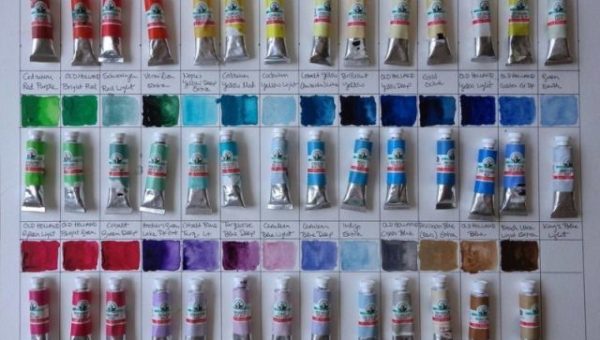
Painting with acrylics: some useful tips (part1)
Acrylic paints are an excellent choice for beginners looking to try their hand at painting. They provide particularly rich colors and dry fairly quickly. They can be used on a large number of media: paper, fabric, canvas on a stretcher bar, glass, wood and ceramics. In this article we are going to discuss the key things you need to know about acrylics when you start painting with them.

Types of acrylic paints
Acrylics are water-dispersion paints and have a paste-like consistency. You can dilute them with water or a special thinner, or leave them as they are. In each scenario, the paint adheres well in a nice even layer, and forms a strong, long-lasting covering.
Acrylics are suitable for both large exterior works, and for decorative works displayed indoors. After drying, a polymer film forms on the layer of paint, which is not affected by moisture or changes in temperature. Meanwhile the colors stay as bright and fresh as they were when you had just finished your painting.
They don’t give off a pungent, unpleasant smell, they don’t emit toxic substances, and they don’t require the use of thinners, so they are a fantastic choice for children wanting to do some painting. They can also be used by pregnant women, and people with allergies and respiratory problems, without having to worry that their condition will worsen or that the paints will damage their health. Moreover, the paints do not contain any flammable components.
Thanks to the great diversity of acrylic paints, you can achieve some remarkable artistic effects with them. One example of this diversity is how they differ in paint content.
- Matt paints do not have a shiny finish, and create a opaque, homogeneous layer after drying.
- Glossy paints create a bright, gleaming surface. This gleam can either be soft and silky, or glossy and like a mirror – it depends on the degree of gloss.
- Fluorescent paints contain a special pigment that glows in the dark. Once the surface has been painted, the sun’s rays must fall on it.
- Pearlescent paints create a surface that refracts light like a real pearl would, as their ingredients include a pigment that reflects light.
- Metallic paints imitate the luster of metal, as they contain a pigment made of aluminium powder.

Acrylic paints can be purchased in tubes or in pots. The paints in tubes are thicker and more viscous; this form of container is suitable for the impasto technique, whereby artists paint in thick, textured strokes. The acrylic paints that come in pots are runnier. They are suitable for filling in large areas and are easier to dilute.
As stated above, they can be used to paint on absolutely anything, but if you are a beginner, it’s best to use a paper canvas on a card background, which has similar properties to a canvas placed in a stretcher bar.
Which paintbrushes should you use when painting with acrylics?
It’s best to use the following types of paintbrush when painting with acrylics:
- brushes with artificial hair (synthetic ones),
- bristle brushes;
- the hardness of the hair should be medium or high.
Soft, natural brushes are not suitable, as acrylic paint is quite heavy, and the brushstrokes will end up looking shapeless and being different sizes, as it will be hard to control them. We recommend having four thick, round brushes of different thicknesses in your arsenal, and also a palette knife.






